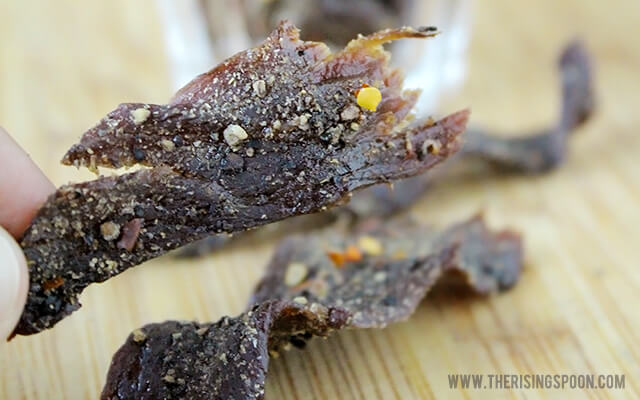You can make beef jerky at home without special tools like a dehydrator. With a few small adjustments, a home oven can dehydrate more food at once than the majority of commercial dehydrators.
Any type of meat can be used to make jerky, but since you won’t need the tenderness of an expensive cut like a filet mignon, it makes sense to buy a cheaper cut. Brisket is a good choice.
I discovered that the beef had been purposefully packaged in the supermarket with a large sheet of fat on the bottom. When shopping, try to avoid it, but otherwise, cut it off. (I’ve since learned that the fat is added on purpose when roasting to keep the food moist.)
Tips & Tricks For Making Homemade Beef Jerky in the Oven

- 2 pounds of lean beef, including top round, bottom round, and flank steak ).
- 1 tablespoon + 2 1/2 teaspoons of cracked black pepper
- 2 1/2 teaspoons sea salt (mostly THIS salt with a small amount of THIS smoked salt).
- 2 1/2 teaspoons of granulated garlic or garlic powder
- 2 1/2 teaspoons of onion powder
- 1 1/4 teaspoons of crushed red pepper
- Other seasonings that I’ve enjoyed in numerous batches (I like to vary it up) include homemade habanero garlic seasoning and lemon pepper seasoning.
- Place your meat in the freezer for 30 to 60 minutes to help it become more firm and easier to cut. When using a large cut of beef, such as a top or bottom roast, trim any visible fat before slicing the meat into thin, even pieces that are typically about 1/8 inch thick, followed by strips that are 1/2 to 1 inch wide. You can cut against the grain or with the grain. Totally up to you. It will only change how the jerky tears when you bite into it.
- Whatever you prefer, just make sure it’s a clean surface that’s easy to clean up. Spread the beef strips out on wax paper, parchment paper, or cookie sheets. Season both sides with the sea salt, garlic, onion, black pepper, and crushed red pepper (or whatever seasonings you prefer). However, I prefer each piece to have a decent amount of each spice on it, so I season them individually. If you want to save time, mix all the spices together first.
- From here, remove your two oven racks and spread the jerky pieces across the wire racks, leaving some space between each piece of meat (it’s okay if they drape down). To prevent it from falling to the oven’s bottom, make sure that each piece of jerky is firmly attached to the rack. Make sure no beef jerky touches the top or bottom of the oven as you carefully slide the racks back into the oven, leaving some space between each one.
- Put a wooden or metal utensil in the oven door to keep it cracked and encourage air circulation. Set the oven to the lowest temperature it will allow (mine is 170 degrees, but if yours goes to 160 or 150 that’s great, too).
- Your jerky pieces should take 5 to 6 hours, depending on their thickness, to completely dry out. You might want to check on the progress of the tiny pieces (if you have any) by taking a peek inside the oven at four. When the jerky is done, it will tear easily but won’t immediately snap in half when compressed. If you leave them in there for a little too long and they become snappy, don’t worry. They still taste delicious!.
- The pieces of jerky should be placed in a sealed container for long-term storage after they have been taken out of the oven and placed on a piece of paper, newspaper, or clean cloth towel to absorb some of the grease. As long as the fat doesn’t go rancid, these should technically last for a few months, but I always eat my batches within 1-2 weeks. You can always store them in the refrigerator if you don’t feel comfortable leaving them out at room temperature. Either way will work!.
- Depending on how thick or thin you (or the butcher) slice the beef, the yield will change. I am 55 wide.
- You may need more spices than this. Everything will depend on how precisely you sprinkle it on the beef and how much of it you use. If there is a lot of spill-off, you will require more. Additional options include wanting more or less of a certain spice. Theres a lot of room for flexibility here!.
Popular Posts Right Now!
HOW to MAKE JERKY – NO Dehydrator Required – Meat Series 04
FAQ
Can jerky be made without a dehydrator?
How to Make Beef Jerky Without a DehydratorSelect Meat. Trim Fat. Partially Freeze Meat (optional) . Slice Strips. Marinade/Season the Meat. Line oven with foil. Arrange strips. Start oven and vent door.
How to make beef jerky without a dehydrated?
Place the strips of meat in a single layer on drying racks after simmering or baking it to 160 degrees Fahrenheit. Avoid overlapping or touching pieces. Dehydrate the strips at 140°F in a smoker, oven, or dehydrator. Maintain a constant dehydrator temperature of 140ºF during the process.
How do you dry jerky naturally?
Because an oven operates at a higher temperature and dries food more quickly than a dehydrator, The flavor of your gourmet beef jerky may occasionally be enhanced by combining various flavors in the oven; this is something you cannot achieve using a dehydrator.
